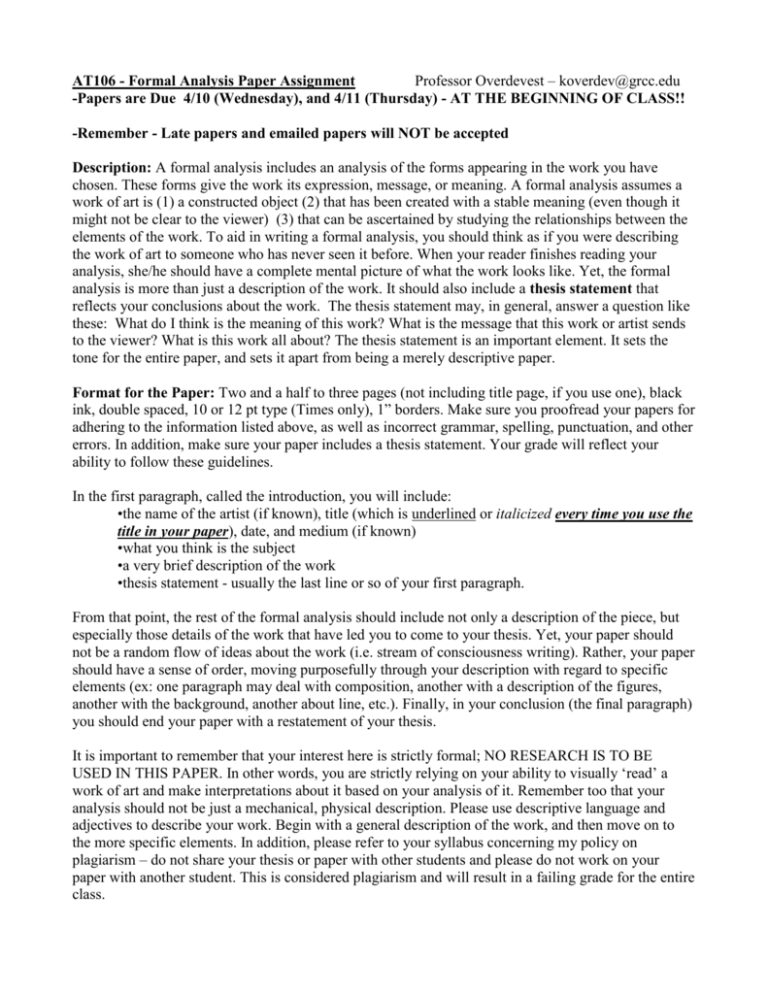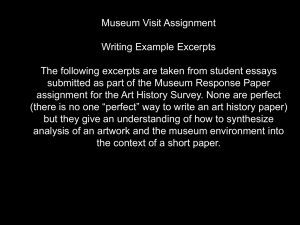Formal Analysis - Art History Teaching Resources
advertisement

AT106 - Formal Analysis Paper Assignment Professor Overdevest – koverdev@grcc.edu -Papers are Due 4/10 (Wednesday), and 4/11 (Thursday) - AT THE BEGINNING OF CLASS!! -Remember - Late papers and emailed papers will NOT be accepted Description: A formal analysis includes an analysis of the forms appearing in the work you have chosen. These forms give the work its expression, message, or meaning. A formal analysis assumes a work of art is (1) a constructed object (2) that has been created with a stable meaning (even though it might not be clear to the viewer) (3) that can be ascertained by studying the relationships between the elements of the work. To aid in writing a formal analysis, you should think as if you were describing the work of art to someone who has never seen it before. When your reader finishes reading your analysis, she/he should have a complete mental picture of what the work looks like. Yet, the formal analysis is more than just a description of the work. It should also include a thesis statement that reflects your conclusions about the work. The thesis statement may, in general, answer a question like these: What do I think is the meaning of this work? What is the message that this work or artist sends to the viewer? What is this work all about? The thesis statement is an important element. It sets the tone for the entire paper, and sets it apart from being a merely descriptive paper. Format for the Paper: Two and a half to three pages (not including title page, if you use one), black ink, double spaced, 10 or 12 pt type (Times only), 1” borders. Make sure you proofread your papers for adhering to the information listed above, as well as incorrect grammar, spelling, punctuation, and other errors. In addition, make sure your paper includes a thesis statement. Your grade will reflect your ability to follow these guidelines. In the first paragraph, called the introduction, you will include: •the name of the artist (if known), title (which is underlined or italicized every time you use the title in your paper), date, and medium (if known) •what you think is the subject •a very brief description of the work •thesis statement - usually the last line or so of your first paragraph. From that point, the rest of the formal analysis should include not only a description of the piece, but especially those details of the work that have led you to come to your thesis. Yet, your paper should not be a random flow of ideas about the work (i.e. stream of consciousness writing). Rather, your paper should have a sense of order, moving purposefully through your description with regard to specific elements (ex: one paragraph may deal with composition, another with a description of the figures, another with the background, another about line, etc.). Finally, in your conclusion (the final paragraph) you should end your paper with a restatement of your thesis. It is important to remember that your interest here is strictly formal; NO RESEARCH IS TO BE USED IN THIS PAPER. In other words, you are strictly relying on your ability to visually ‘read’ a work of art and make interpretations about it based on your analysis of it. Remember too that your analysis should not be just a mechanical, physical description. Please use descriptive language and adjectives to describe your work. Begin with a general description of the work, and then move on to the more specific elements. In addition, please refer to your syllabus concerning my policy on plagiarism – do not share your thesis or paper with other students and please do not work on your paper with another student. This is considered plagiarism and will result in a failing grade for the entire class. 2 For Help: •Writing help is available on the fifth floor of Cook Hall at the Writing center. -They allow drop-ins. •See Sylvan Barnett’s A Short Guide to Writing about Art – Thesis and formal analysis sections •Remember that I am also available via office hours, email, and telephone Things to consider when writing a formal analysis (in no particular order): Keep in mind that you always need to Back Up Your Statements! 1. Record your first impression(s) of the artwork. What stands out? Is there a focal point (an area to which the artist wants your eye to be drawn)? If so, what formal elements led you to this conclusion? Your impressions can help you reach your thesis. 2. What is the subject of the artwork? 3. Composition: How are the parts of the work arranged? Is there a stable or unstable composition? Is it dynamic? Full of movement? Or is it static? 4. Pose: If the work has figures, are the proportions believable? Realistic? Describe the pose(s). Is the figure active, calm, graceful, stiff, tense, or relaxed? Does the figure convey a mood? If there are several figures, how do they relate to each other (do they interact? not?)? 5. Proportions: Does the whole or even individual parts of the figure(s) or natural objects in the work look natural? Why did you come to this conclusion? 6. Line: Are the outlines (whether perceived or actual) smooth, fuzzy, clear? Are the main lines vertical, horizontal, diagonal, or curved, or a combination of any of these? Are the lines jagged and full of energy? Sketchy? Geometric? Curvilinear? Bold? Subtle? 7. Space: If the artist conveys space, what type of space is used? What is the relation of the main figure to the space around it? Are the main figures entirely within the space (if the artwork is a painting), or are parts of the bodies cut off by the edge of the artwork? Is the setting illusionistic, as if one could enter the space of the painting, or is it flat and two-dimensional, a space that one could not possibly enter? 8. Texture: If a sculpture, is the surface smooth and polished or rough? Are there several textures conveyed? Where and How? If a painting, is there any texture to the paint surface? Are the brushstrokes invisible? Brushy? Sketchy? Loose and flowing? Or tight and controlled? 9. Light and Shadow: Are shadows visible? Where? Are there dark shadows, light shadows, or both? How do the shadows affect the work? 10. Size: How big is the artwork? Are the figures or objects in the work life-sized, larger or smaller than life? How does the size affect the work? 11. Color: What type of colors are used in the work? Bright? Dull? Complimentary? Does the artist use colors to draw your attention to specific areas of the work? How? If a sculpture, examine the color(s) of the medium and how it affects the work. 12. Mood: Do you sense an overall mood in the artwork? Perhaps several different moods? If so, describe them. How does the mood interpret how you view the work? Once you have spent some time analyzing your work, notice if your first impression of the work has changed, now that you have taken a closer look? How? If you came up with a thesis statement before doing this in-depth analysis, you may want to change it if your impression of the work has changed. Your thesis statement should reflect your view of the object. 3 Object Choices for the Paper – choose one of these works below as the focus of your paper -At the new Grand Rapids Art Museum -gramonline.org -101 Monroe Center phone: 616-831-1000 -hours: Tues thru Thurs: 10-5, Friday: 10-9, Saturday, 10-5, Sunday: 12-5, Closed Mondays -on street parking (bring some change), but walk-able from GRCC. -when you get in to the Museum and are at the ticket counter, ask for a map of the museum. This will help you find the different rooms that contain the works -bring your student ID to get in free 1. Andrea Kowch, Sojourn, 2011. First floor, central panel wall adjacent to the bathrooms 2. Chris Van Allsburg, Just Desert, 1983. First floor, adjacent to the elevator 3. George Innes, Sunset in the Woods, 1883. Second Floor, Gallery I 4. Adonna Khare, Elephants, 2012. Second floor, adjacent to the elevator 5. William Merrit Chase, Portrait of Miss C. (Lady in Opera Cloak), c1893. Second Floor, Gallery I 6. Gerrit Albertus Beneker, Provincetown Pier, Winter, 1918. Second Floor, Gallery I 7. Charles Howard, The Independent Source, 1950. Third Floor, Gallery I 8. Timothy Cleary, Promise, 2012. Third Floor, Gallery IV







